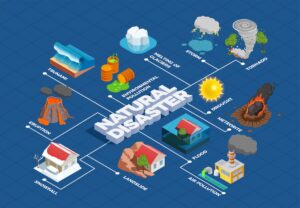Climate change has emerged as one of the most pressing global challenges, with rising temperatures, extreme weather events, and environmental degradation threatening ecosystems, economies, and human health. As the world seeks solutions to mitigate and adapt to climate change, Artificial Intelligence (AI) is proving to be a powerful ally in the fight for a sustainable future. By harnessing the capabilities of AI, we can improve our understanding of climate patterns, optimize energy consumption, and develop innovative technologies to reduce carbon emissions.
This article explores the key roles AI plays in addressing climate change, from predictive analytics to renewable energy optimization, and examines the potential it holds for transforming the way we tackle this global crisis.
One of the most significant contributions AI can make in combating climate change is in the realm of climate modeling and predictive analytics. AI-powered models can analyze vast amounts of historical climate data, satellite images, and environmental variables to predict future climate trends, such as temperature rises, rainfall patterns, and the likelihood of extreme weather events. These models help scientists, policymakers, and organizations anticipate climate-related risks and make informed decisions on mitigation and adaptation strategies.
For example, AI can assist in predicting the effects of climate change on agriculture, water resources, and human health. By processing complex datasets, AI algorithms can forecast how climate shifts may affect crop yields or how changing weather patterns may lead to water shortages in certain regions. With this data, stakeholders can plan and implement proactive measures to minimize negative impacts.
AI-powered models can also improve our understanding of the carbon cycle by simulating the movement of greenhouse gases, including carbon dioxide, across the atmosphere, oceans, and land. These insights allow for more accurate assessments of how carbon emissions are distributed and how different sectors contribute to climate change.
Energy production and consumption are at the heart of the climate change crisis, with fossil fuels being a major source of greenhouse gas emissions. AI can play a crucial role in optimizing energy efficiency across various sectors, from power generation to transportation.
1. Smart Grids
AI can help optimize energy distribution systems, particularly through the development of smart grids. These grids use real-time data and machine learning algorithms to balance supply and demand, ensuring that energy is used as efficiently as possible. AI can also predict energy demand fluctuations, enabling better planning and reducing energy waste.
In addition, AI can integrate renewable energy sources, such as solar and wind, into the grid more effectively. By predicting fluctuations in energy generation based on weather patterns and other factors, AI can ensure that the grid adjusts to renewable energy availability and reduces reliance on fossil fuel-based power sources.
2. Energy Consumption Optimization
On an individual level, AI can help optimize energy consumption in homes, offices, and industrial settings. Smart thermostats, lighting systems, and appliances powered by AI can learn a user’s preferences and adjust energy usage accordingly, reducing waste and lowering carbon footprints.
AI-driven systems can also help companies monitor and optimize the energy consumption of their operations. For instance, AI algorithms can identify inefficiencies in manufacturing processes or logistics networks, suggesting ways to reduce energy consumption, optimize supply chains, and minimize emissions.
AI is playing a key role in accelerating the development and deployment of renewable energy technologies. Whether it’s solar, wind, or hydropower, AI can be applied in various stages of energy production to make these systems more efficient, scalable, and cost-effective.
1. Optimizing Renewable Energy Production
AI can improve the efficiency of renewable energy generation by predicting the best locations for wind turbines, solar panels, or hydroelectric dams. By analyzing weather patterns, geographical data, and environmental conditions, AI can recommend the optimal placement of renewable energy infrastructure to maximize energy output.
For example, AI-powered software can analyze weather data to predict cloud cover and sunlight intensity, optimizing the placement and angle of solar panels to ensure they capture the maximum amount of solar energy throughout the day. Similarly, AI can help identify the most efficient wind turbine configurations based on local wind patterns.
2. Energy Storage and Grid Integration
One of the major challenges with renewable energy, particularly solar and wind, is intermittency—the fact that energy production can fluctuate depending on weather conditions. AI can help address this challenge by improving energy storage systems and enhancing the integration of renewable energy into the grid.
AI can predict periods of high or low energy production and optimize the charging and discharging of energy storage systems, ensuring that excess energy is stored for later use. This enables a more reliable supply of renewable energy, reducing the need for fossil-fuel-based backup power.
As the world seeks to reduce carbon emissions, carbon capture technologies are becoming an important part of the solution. AI can enhance carbon capture processes by optimizing the efficiency of carbon capture and storage (CCS) systems, which capture CO2 emissions from industrial processes and power plants before they can enter the atmosphere.
AI algorithms can analyze emissions data to identify the most effective locations for capturing CO2, monitor storage facilities to ensure that CO2 remains securely stored, and predict the long-term impacts of carbon capture on the environment. AI is also being used in the development of direct air capture (DAC) technologies, which capture CO2 directly from the atmosphere.
In the realm of climate engineering, AI is helping researchers explore innovative geoengineering techniques, such as solar radiation management or ocean fertilization, which aim to mitigate the effects of climate change by manipulating natural processes. While these techniques remain controversial and require extensive research, AI is being used to model and simulate their potential impacts.
Agriculture is both a contributor to and a victim of climate change. As global temperatures rise and extreme weather events become more frequent, agricultural productivity is at risk. AI is being applied to sustainable agriculture practices, helping farmers adapt to changing conditions and minimize their environmental impact.
1. Precision Agriculture
AI can optimize crop production through precision agriculture—a farming approach that uses data and technology to monitor and manage agricultural practices more efficiently. AI-powered sensors, drones, and satellite imagery allow farmers to collect real-time data on soil health, moisture levels, and crop conditions. This data is then analyzed to make informed decisions about irrigation, fertilization, and pest control, reducing resource use and minimizing environmental harm.
2. Climate-Resilient Crops
AI is also aiding in the development of climate-resilient crops by analyzing genetic data and environmental conditions to identify plant traits that are more resistant to drought, heat, and other climate-related stresses. AI models can predict how different crops will perform under various climate scenarios, helping to ensure food security in the face of climate change.
AI is playing a vital role in raising awareness about climate change and advocating for policy changes. AI-driven platforms can analyze large amounts of data from scientific research, social media, and news sources to track climate change trends, identify areas of concern, and provide actionable insights for governments, NGOs, and the public.
AI is also helping to develop climate simulations that can demonstrate the potential outcomes of different climate policies, guiding policymakers in making data-driven decisions to combat climate change effectively.
AI has the potential to be a game-changer in the fight against climate change, offering innovative solutions across a wide range of sectors, from energy and agriculture to carbon capture and climate modeling. By harnessing the power of AI, we can optimize energy usage, accelerate the adoption of renewable energy, reduce emissions, and better understand the impacts of climate change.
However, the full potential of AI can only be realized with global collaboration, investment in research and development, and a commitment to using AI for the greater good. As the world faces increasingly urgent climate challenges, AI offers a beacon of hope, providing the tools needed to drive meaningful, lasting change for a sustainable future.
For more information visit the following sites:





